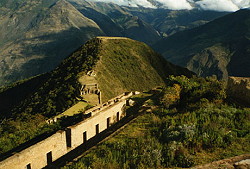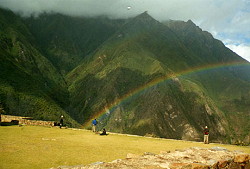
Photo. The amazing Inca wonder Choquequirao viewed from a hill. © Alex Welsh.
The starting point is Cachora, a charming sleepy village at the bottom of a valley. A bus from Cuzco drops you off just before it gets to Abancay. You have to spiral downwards for two hours to get to the village.
Once there, things were easy to find. Cachora is the mule depot of the mountain range. There is a pretty basic hotel, a basic place to eat some potatoes or soup, and a basic shop to buy basic provisions. Water is not essential if you have purifying tablets – you will come across many springs on the way. I’m not sure, but I think they pretty much pull whatever villager is available when you ask for a guide. They are all good anyway. Our guide for the trek was Victor – a farmer who had done the 7-day trek to Santa Teresa 12 times. Luigi (my buddy) and me also rented two mules: one for the backpacks and one for riding, if required.
The first day is a gradual shedding of civilisation. We went through the village, kids running after us, adults smiling and wishing good luck. Then some farmland with an occasional campesino. Then an abandoned hacienda and a short forest trail, and, finally, the mountains.
For three hours or so it was a leisurely promenade on a wide flat trail. The serenity…just the birds, the sun and the peaks bathed in sunlight. The road wound round the bends like a box of chocolates: at every corner a new view, more impressive than the one before. A wall on the left, a drop on the right, and a bunch of summits as far as the eye can see.
Photo. Choquequirao in the rainbow.
© Alex Welsh. |
 |
Later, the soil changed from grey rocks to red powder and we began our descent into the Apurimac river valley. We reached the Chiquisca camping station right in time for the dark. It was no more than a cleared patch of wood, 20 m in diameter, looked after by a 14 year old girl living there in almost total solitude. That was the most institutionalised accommodation we were to encounter for the rest of the trail.
We woke up in the clouds, literally. They were all around us. You could wash your face in them. Our guide took us to the edge of a cliff and pointed out the task for the day. A vertical wall going all the way into the sky, the trail a thin cord zigzagging schizophrenically over its face like a crack. It looked totally intimidating. But first we had to come down into the valley and cross the Apurimac River that separated us from the wall.
So we did, slowly, savouring the stereotypical scorched cactus scenery of the valley. The bridge was modern and strong (I guess the government attended to that in search of some tourist revenue). Finally, the ascent: 3 hours of mind-numbing grunt work. Left, push, right, push, left, push, right, push. Water was going by the gallons. But the views were unobstructed and once you detach from the physical effort you mind floats in the mountains.
Three hours later we came across a few huts (Santa Rosa settlement) and rested with one of the owners. We stayed for a while, tired and soaking up the sunny afternoon with our numbed brains. Could have stayed there forever. Then another 2 hours of grunt-work ascent and we break the gradient – finally there, on a flat top. Looking back at the thin silver string of the river down in the valley, I couldn’t believe we got so far.
There were a couple of huts at the top. We camped outside the house of the local bear hunter, an amazing guy full of life. He warmly welcomed us to his wife’s cooking. The reason he is so happy is because from his porch you can see the most beautiful sunset panorama on the planet.
Next morning we got our first sighting of Choquequirao just a few steps from the settlement. But it took another one and a half hours of beating the trail to get there. We dived into the woods, stepped out of a bush and there we were – on the terraces of the Lost City, just like that. No gates, no tickets, not a soul.
Choquequirao was the jewel of my trip. Sure, Machu Picchu is gorgeous and if you are looking for convenience, you can be there and back in one day. Choquequirao takes 4 days of hard walking and that is why it is so serene, challenging, profound and rewarding. It is a true Lost City.
You get back the same way you came. For me, the journey to Choquequirao was the first leg of the 7-day trek over the mountains to Machu Picchu (if you wanted to know whether that could be done). But that’s another story.
Alex Welsh, 3 July 2006
Additonal information
Notes by Alex Welsh:
This trek took place in August 2002. There have been some changes, although minor. The entry to Choquequirao is now purchased at 10 soles, this lasts you as long as you want. The camping on the terrace now includes toilets and an emergency line with Cachora.
The destination is also getting more popular, although still far from crowded: in the high season of July/August 2005 there was an average of 50 visitors on site plus about the same number en route at any time. Hurry before they build a railway!
The trek can be completed in 4 days if needed, but you only get 1 hour on site: you carry on straight to Choquequirao on your 2nd day, have a tour in the morning and set off, arriving to the Apurimac River crossing by night. For any treks to Choquequirao make sure you have adequate footwear and you are accustomed to the altitude: that second day will get you sweating and your ankles twisting.
General information about Peru:
Peru is probably one of the richest countries in the world when it comes to ancient wonders and mysteries. The whole country is filled with discovered and undiscovered treasures. It also has some of the most spectacular and varied scenery in South America. The biggest treasure in the country is the people itself: their hospitality and friendliness are unique!
Peru is a country in South America, situated on the western side of that continent. It face the South Pacific Ocean and cover a part of the Andes mountain range that runs the length of South America. Peru is bordered by Ecuador and Colombia to the north, Brazil and Bolivia to the east, and Chile to the south.
Read more about Peru on Travel Explorations. Here you find stories and information about Machu Picchu, Nazca Lines and many more mysteries and wonders.
About the Author:
Alex Welsh is the webmaster of Valencia Travel Guide - an independent resource on travelling to Valencia.












